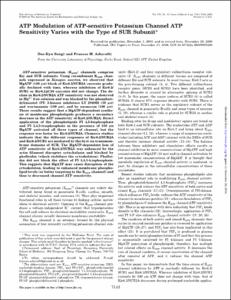ATP Modulation of ATP-sensitive Potassium Channel ATP Sensitivity Varies with the Type of SUR Subunit
- Keimyung Author(s)
- Song, Dae Kyu
- Department
- Dept. of Physiology (생리학)
- Journal Title
- Journal of Biological Chemistry
- Issued Date
- 2001
- Volume
- 276
- Issue
- 10
- Abstract
- ATP-sensitive potassium (KATP) channels comprise Kir and SUR subunits. Using recombinant KATP channels expressed in Xenopus oocytes, we observed that MgATP (100 μm) block of Kir6.2/SUR2A currents gradually declined with time, whereas inhibition of Kir6.2/SUR1 or Kir6.2ΔC36 currents did not change. The decline in Kir6.2/SUR2A ATP sensitivity was not observed in Mg2+ free solution and was blocked by the phosphatidylinositol (PI) 3-kinase inhibitors LY 294002 (10 μm) and wortmannin (100 μm), and by neomycin (100 μm). These results suggest that a MgATP-dependent synthesis of membrane phospholipids produces a secondary decrease in the ATP sensitivity of Kir6.2/SUR2A. Direct application of the phospholipids PI 4,5-bisphosphate and PI 3,4,5-trisphosphate in the presence of 100 μm MgATP activated all three types of channel, but the response was faster for Kir6.2/SUR2A. Chimeric studies indicate that the different responses of Kir6.2/SUR2A and Kir6.2/SUR1 are mediated by the first six transmembrane domains of SUR. The MgATP-dependent loss of ATP sensitivity of Kir6.2/SUR2A was enhanced by the actin filament disrupter cytochalasin and blocked by phalloidin (which stabilizes the cytoskeleton). Phalloidin did not block the effect of PI 3,4,5-trisphosphate. This suggests that MgATP may cause disruption of the cytoskeleton, leading to enhanced membrane phospholipid levels (or better targeting to the KATPchannel) and thus to decreased channel ATP sensitivity.
- Keimyung Author(s)(Kor)
- 송대규
- Publisher
- School of Medicine
- Citation
- Dae-Kyu Song and Frances M. Ashcroft. (2001). ATP Modulation of ATP-sensitive Potassium Channel ATP Sensitivity Varies with the Type of SUR Subunit. Journal of Biological Chemistry, 276(10), 7143–7149. doi: 10.1074/jbc.M009959200
- Type
- Article
- ISSN
- 0021-9258
- Appears in Collections:
- 1. School of Medicine (의과대학) > Dept. of Physiology (생리학)
- 파일 목록
-
-
Download
 oak-aaa-2327.pdf
기타 데이터 / 190.64 kB / Adobe PDF
oak-aaa-2327.pdf
기타 데이터 / 190.64 kB / Adobe PDF
-
Items in Repository are protected by copyright, with all rights reserved, unless otherwise indicated.